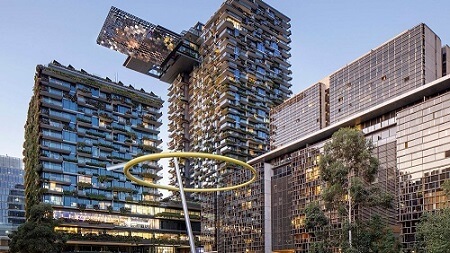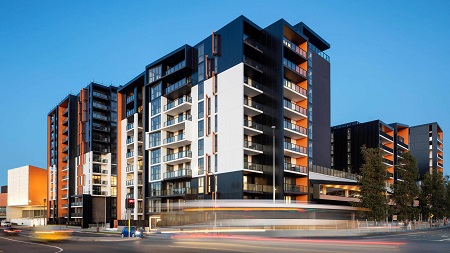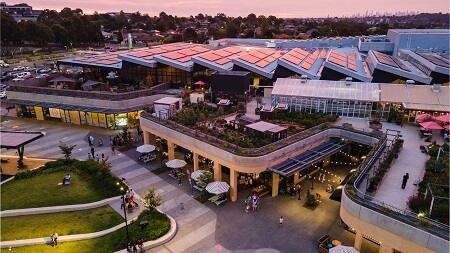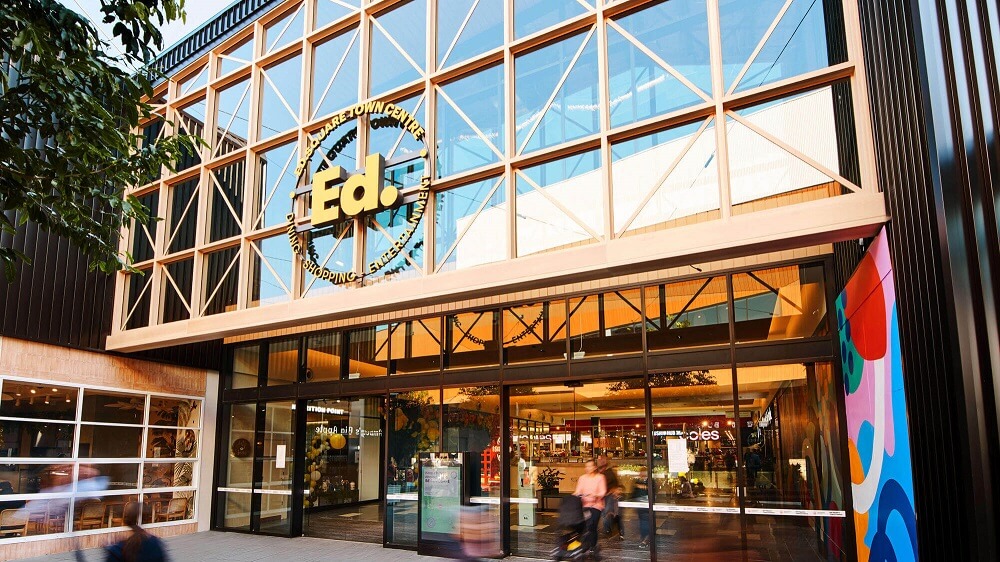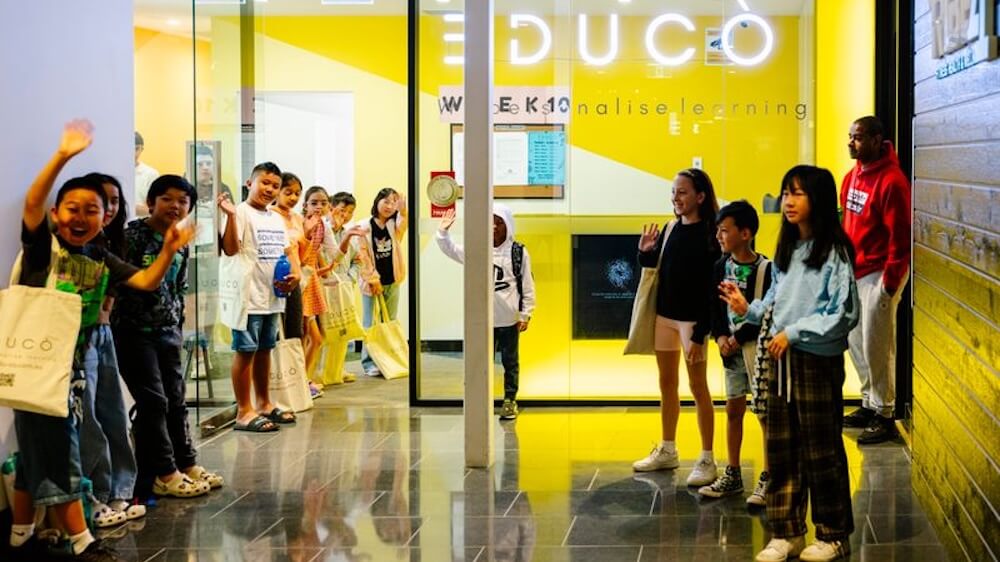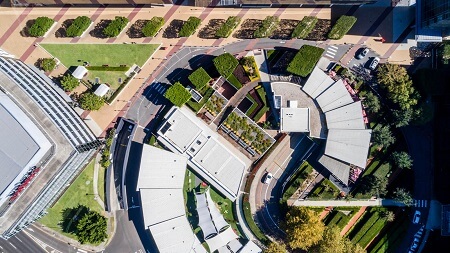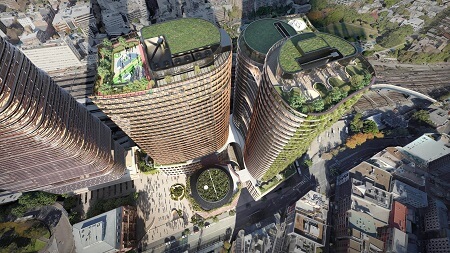The fascinating history of the Bradmill Denim Factory
A tale of industry, inclusivity, and innovation

As we mark 100 years of creating iconic Australian places, we're proud to unveil Bradmill Yarraville, a new community built on the foundations of a proud Melbourne institution, whose name was known around the world for quality and ingenuity.
At its height, the Bradmill Denim Factory in Yarraville produced 36 million square metres of cotton denim a year, almost enough to wrap the world. Through five decades of operation, the factory's employees built lives and forged friendships, creating cherished memories along the way. Though the looms have fallen silent, the threads of togetherness woven within Bradmill's walls remain unbroken, a testament to the lasting impact of this iconic Australian institution.
The birth of Bradmill

Founded in Sydney in 1927 and expanding its operations into Victoria in 1940, Bradford Cotton Mills was, by the middle of last century, the largest producer of textiles in the country. In the late 1950s, a new factory on Francis Street, Yarraville was opened, and the company changed its name to Bradmill. Over the next 50 years, the facility integrated cutting-edge technologies and employed thousands of workers, eventually earning global recognition for its innovative denim production.
Bradmill was a hub of ceaseless activity, with machines running non-stop. At its peak, the factory produced a staggering 36 million square meters of cotton denim annually. "Almost enough to wrap the globe," says former Bradmill Managing Director, Rob Dickson.
Besides cotton and denim, the company produced materials like Colvadure, nylon, polyester, rayon, elastomeric stretch yarns and more for various products. Known for their durability and strength, Bradmill's canvases could be found in a range of products from firehoses and deck chairs to tents and tarpaulins.

The scale of the factory's operations required enormous resources. It used 40,000 bales of cotton a year, was the third-largest water user in Victoria, and consumed so much electricity that a single bill could exceed a million dollars.
Despite the twin challenges of increased competition and inflation in the 1980s, Bradmill thrived on innovation. Venturing into new export markets and developing pioneering products, Bradmill invested in state-of-the-art spinning equipment from Germany, which ran 24/7 and attracted global attention.
"This little place in Yarraville attracted people from Switzerland and Germany because there was nowhere else in the world where these machines were running 24/7," says former Operations Manager, Bob Green. "They sent their engineers to find out what we were doing, and to be doing it so well. They couldn't believe what we were able to do."
By the 1990s, Bradmill denim accounted for a significant portion of the business. Their stretch denim was globally renowned and sought after by luxury brands like Dolce & Gabbana. Bradmill even pioneered "Dirty Denim," a proprietary process that created distinctive denim effects popularised by fashion brand, Diesel.
"We were small in comparison to other big overseas operations," says former CEO Allan Kerr, "But we were very well regarded because of our quality, innovation, and relationships."
Despite Bradmill's reputation and the best efforts of their management team, the pressure of cheap imports eventually pushed Bradmill into receivership in the early 2000s. The site was shuttered, laying dormant for two decades before being bought by Frasers Property Australia and partner, Irongate, who will resurrect Bradmill's 26 hectares into a vibrant new Yarraville neighbourhood.
Putting people first

Bradmill became like a second home for many of those who worked there. They found a sense of belonging and camaraderie that sustained decades-long careers, in some cases from apprenticeship to retirement. Lynne Carr fondly remembers her time at Bradmill, saying, "There was something that was extraordinarily welcoming about the whole place."
According to Bob Green, this welcoming atmosphere was deeply ingrained in the company's culture. "Put people first, and we will succeed" was the mantra. Employees understood that every job, no matter how seemingly small, was crucial to the company's success.
Many new employees were welcomed into Bradmill by family or friends, creating a warm and personal introduction to the company. Family connections not only helped newcomers adjust but also built a sense of safety and belonging.
Lupco Masalkovski's story exemplified this sense of community. He migrated to Australia at the age of twenty and found his first job at Bradmill, where his uncles worked. "Everyone encouraged me to learn the English language, and then it all became easier and better," he says. Lupco stayed with the company for twenty-five years until it closed.
Steve Pellegrino, who joined Bradmill at nineteen years old and stayed for 36 years, felt a deep sense of loyalty to the company. "It was a great place to work, and I enjoyed being there," says Steve. "It was all the people I used to work with; in a way it was like a family. I started there and I never left."
The Bradmill family

The people of Bradmill considered themselves part of a unique family. They shared their workdays, meals, and social lives. From celebrating each other's achievements to attending weddings and birthdays, lives were intertwined both inside and outside the factory gates.
Julie Block, an Office Administrator at Bradmill, fondly remembers how people gathered for morning tea and shared stories about their families. Multiple generations often worked side by side, creating a deep sense of familial connection. "It was a very family-oriented place to work," she says. "Of all the places I've worked, what we had at Bradmill was rare."
Michael Chong, who worked in the Bradmill Testing Lab, shared how his colleagues helped prepare for his wedding when he couldn't afford it himself.
"I didn't have the money…but the lab assistants knew I was on my own and that I met somebody; so, they all helped to prepare for my wedding. They brought things…they decorated the place up. You don't get that anywhere else, so for me, that was very sentimental.
And they were so happy for me. It was a cheap wedding, but it was happy. That's one of those things you cannot buy with money."
Even today, more than two decades since Bradmill's closure, people stay in touch. Office Administrator Jacqui Carton set up a Facebook page to ensure that everyone who ever worked at Bradmill Yarraville would have access to details of the next annual reunion.
"The people that worked at Bradmill were multigenerational and multicultural," said Jacqui. "It felt like a big family and that's why it probably endured and why there's longevity to the relationships."
Despite the familial bonds at Bradmill, external challenges challenged the company's existence. The end of tariffs and changes in ownership led to a turbulent period, ultimately ending in receivership. For many loyal employees who had dedicated their lives to Bradmill, the closure of the factory was a devastating blow.
Steve Tjobanakis, a Textiles Mechanic & Supervisor, summed up the loss: "Our family had been broken apart."
United nations

In the late 1980s, Melbourne's The Age newspaper, profiled Bradmill as a microcosm of multiculturalism, with at least 34 home countries represented among the 1200-strong workforce. The diversity was fluid and dynamic, shaped by global events and Australian migration policies.
The factory's early migrants were often skilled workers from Northern Europe. The 1960s saw a significant influx of Greek and Italian migrants. The following decade witnessed a surge in migration from Yugoslavia. By the late '80s, Portugal was represented as were people from South America. Despite their different backgrounds, the Bradmill workers embraced each other as equals.
"We were like the United Nations," says Georgia Kikidis. "People from all around the world came together."
Her colleague, Vic Muscat concurs: "Many people had escaped wars — Vietnam, Lebanon, Greece — and found a peaceful country, a place to heal. Bradmill gave them that."
James Zhou, a Weaving Technician, recalled a poignant moment from the early 1990s when tensions were high due to the Yugoslav wars. At Bradmill, employees from nations affected by the conflict — Bosnians, Serbians, Croatians, Macedonians — found solace and solidarity within the factory's walls. Instead of division, they forged even stronger friendships.
"What was amazing for me was that they became even better, closer friends during this time," says James. "You would think that with the war they wouldn't talk to each other or hate each other but at Bradmill they did not do that. They become better friends! They treated each other like a family member."
Arriving in Yarraville from China, James remembers being astounded by the multicultural neighbourhood that surrounded Bradmill. As he walked along Francis Street, he marvelled at the houses with front gardens— something entirely new to him. "I'd never seen this type of street in Shanghai before," he says. "All the houses (were laid out) one by one and each one had a front garden! All the gardens had different flowers and plants and a lawn. I'd never seen this before in my life."
The residential area near Bradmill, primarily inhabited by Greek migrants, also made a profound impression on Rob Dickson. He recalled how the post-war era had transformed Yarraville into a vibrant and culturally diverse neighbourhood, resembling a European enclave.
"The first major group of migrant workers came from Italy, then came the Greeks and in the 1970s it was the Yugoslavs," says Rob. "They dug up their front gardens and grew all sorts of vegetables. People came here with farming backgrounds and created what they had had at home. Women would take big bags into the paddocks and collect wild weeds to take home and cook."
Pride in quality
For decades, Bradmill was known for its commitment to producing top-tier denim products. This commitment was deeply ingrained in every aspect of its operations, from cutting-edge textile techniques and technology as well as rigorous testing of its products.
This commitment to quality paid off with Bradmill becoming a primary supplier for Levi Strauss and other renowned brands like Wrangler, Ralph Lauren, Moschino, and Calvin Klein.
The heart of Bradmill's quality control was its Testing Laboratory. Each team member had a specific focus, whether it was colourfastness, shrinkage, or tensile strength. Michael Chong provided a glimpse into the meticulous testing conducted on the fabric.
"The science behind textiles is far more intricate than what people think, and the number of things textiles do is incredible," he explains "All the work was done in a controlled environment and…they would run the test more than once. That's why their quality control was so good. I worked for several textile companies over the years, and none have done as much quality testing as Bradmill."
The fabric of Australian life
From clothing and household goods to industrial applications and even defence force equipment, Bradmill's products were integral to the fabric of Australian society. The company proudly boasted its homegrown roots, showcasing its role as a major contributor to the nation's economy and identity.
Australia's rich mineral wealth found an ally in Bradmill. The company's conveyor belting played a crucial role in extracting millions of tons of minerals and ores from mines and quarries. When it came to road safety, Bradmill nylon tire cord went into 750,000 Australian-made tires annually.
The Australian Defence Force and law enforcement agencies turned to Bradmill for high-strength Kevlar textiles for personal protection. Bradmill cotton clothed school kids and tradies via the King Gee brand. The company even played a role dressing our Melbourne Olympians in their fleecy-cotton fabric tracksuits in 1956.
But it was Bradmill's reputation in the fashion world that saw its name soar in the 1980s. Renowned fashion brands like Levi Strauss, Blues Union, Sterling, Westco, Marks and Spencer, and Wrangler used Bradmill denim. The company's influence reached international shores, with exports to four continents. Italy became the brand's most successful export market, with Bradmill stretch denim used by iconic fashion brands like Max Mara, Moschino, and Versace.
Celebrations and social life

Beyond the hum of machinery and the clatter of looms, Bradmill was a place where people came together to celebrate life's small moments and big milestones.
Whether it was sharing meals in the canteen or attending each other's weddings, rituals of togetherness strengthened the bonds of the Bradmill community.
The annual Christmas breakup parties were highly anticipated events, often starting early in the morning and continuing until the afternoon. These gatherings brought together people from different departments, fostering a sense of celebration and unity.
The festivities were an opportunity for employees from diverse cultural backgrounds to share their traditions and dishes. The lamb on a spit, cheeses, salads, and unique delicacies created a mosaic of flavours, reflecting the multicultural makeup of Bradmill. Colleagues exchanged gifts, and Santa Claus — mostly portrayed by Bob Green — made an appearance.
The upright piano in the Bradmill canteen was used to celebrate many occasions and add a touch of enchantment to everyday life at Bradmill. Affectionately known as "The Piano Man," Bob Green would often entertain by tickling the ivories. Employees would join in, singing along.
Mealtimes were opportunities for socialising and building friendships. Employees gathered in department tearooms or the expansive canteen.
"We all brought our own lunches. The food that we shared was whatever we grew in abundance in our gardens," says Dimitra Kanellos. "If I had lots of apricots or figs, I would bring a bag and share these with my work colleagues. Sometimes we would share our tomato crops. One lady brought in her plums. My cousin and another lady grew apples that they shared with everyone."Even after the closure of the factory, the spirit of Bradmill lives on through annual reunions. Bob Green plays a pivotal role organising the events, ensuring that the Bradmill family remains connected across the years.
"For the past fifteen years, once a year, we have a reunion," says John Sutton, a Fitter and Turner. "We mix with one another and tell our stories; some people we only see once a year."
Looking to the future
The transformation of the Bradmill Denim Factory in Yarraville into a mixed-use community by Frasers Property Australia will be a harmonious blend of the old and the new, paying homage to the factory's past while supporting a vibrant future.
The iconic heritage buildings at Bradmill, including the boiler house, proofing plant, and dye house, will be repurposed to include a mix of community, leisure and residential uses. Other elements of Bradmill's history may come through in street names, urban design, and public art exhibitions.
The Bradmill redevelopment has received a warm welcome from the local community. Many, like Lynne Carr see the development as a positive step for a site that's been left derelict for so long.
"I think it's wonderful for the area," she says. "It's such a vast piece of land not to be used. There are so many people that want to live closer to the city. And to get that opportunity, people will love it."
Fiorella Fabian warmly welcomes the new residents and hopes they find the same sense of community and joy that were a hallmark of her Bradmill experience.
"We welcome the new residents of Old Bradmill now and hope that they are happy and find the same sense of community and joy in the simple things around us. We may be building lives on post-industrial foundations, but we deserve every good thing that we keep as precious, together."
Discover Bradmill Yarraville! Visit our project site to explore the vibrant new community Frasers Property is crafting with care and innovation. To learn more about our other exciting projects in Victoria, visit our Now Selling page.
See more articles on




